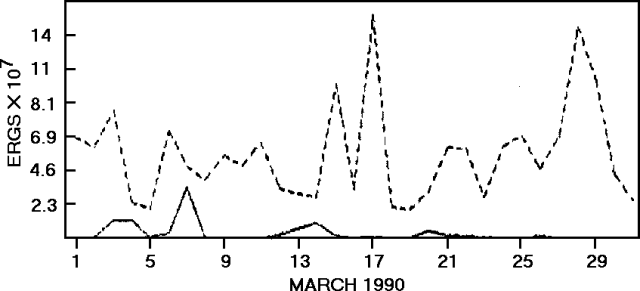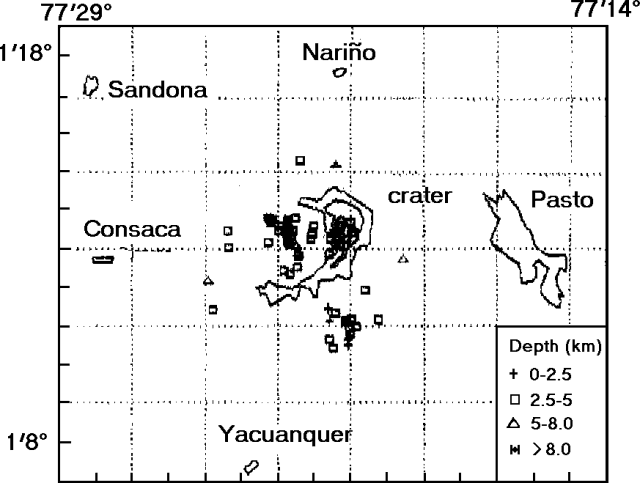Report on Galeras (Colombia) — March 1990
Bulletin of the Global Volcanism Network, vol. 15, no. 3 (March 1990)
Managing Editor: Lindsay McClelland.
Galeras (Colombia) Small phreatic ash emissions with spasmodic tremor and long-period seismicity
Please cite this report as:
Global Volcanism Program, 1990. Report on Galeras (Colombia) (McClelland, L., ed.). Bulletin of the Global Volcanism Network, 15:3. Smithsonian Institution. https://doi.org/10.5479/si.GVP.BGVN199003-351080
Galeras
Colombia
1.22°N, 77.37°W; summit elev. 4276 m
All times are local (unless otherwise noted)
Small phreatic ash emissions continued in March, accompanied by spasmodic tremor and long-period seismicity (table 2). Incandescence was mainly observed in the W part of the crater. The number of low-frequency earthquakes increased 47% relative to February values, with an 86% increase in seismic energy release. However, the number of high-frequency events decreased 38% from February and energy release declined 28% (figures 17 and 18). Most earthquakes were centered in two zones under, W of, and S of the summit (figure 19). SO2 emissions measured on 15 and 22 March by COSPEC were at low-moderate levels, ranging from 630 to 1,380 t/d.
Table 2. Phreatic ash emissions and associated seismicity at Galeras, March 1990. Courtesy of INGEOMINAS.
| Date | Time | Seismic Signal |
| 09 Mar 1990 | 0233 | Spasmodic tremor |
| 11 Mar 1990 | 1448 | Spasmodic tremor |
| 11 Mar 1990 | 1618 | Spasmodic tremor |
| 11 Mar 1990 | 1652 | Long-period |
| 11 Mar 1990 | 2036 | Spasmodic tremor |
| 17 Mar 1990 | 1817 | Long-period |
| 17 Mar 1990 | 1921 | Spasmodic tremor |
| 18 Mar 1990 | 0631 | Spasmodic tremor |
| 27 Mar 1990 | 0609 | Long-period |
| 27 Mar 1990 | 1552 | Spasmodic tremor |
| 28 Mar 1990 | 1359 | Spasmodic tremor |
| 29 Mar 1990 | 0948 | Spasmodic tremor |
 |
Figure 18. Daily energy release of high-frequency (dashed line) and low-frequency (solid line) seismicity at Galeras, March 1990. Courtesy of INGEOMINAS. |
Geological Summary. Galeras, a stratovolcano with a large breached caldera located immediately west of the city of Pasto, is one of Colombia's most frequently active volcanoes. The dominantly andesitic complex has been active for more than 1 million years, and two major caldera collapse eruptions took place during the late Pleistocene. Long-term extensive hydrothermal alteration has contributed to large-scale edifice collapse on at least three occasions, producing debris avalanches that swept to the west and left a large open caldera inside which the modern cone has been constructed. Major explosive eruptions since the mid-Holocene have produced widespread tephra deposits and pyroclastic flows that swept all but the southern flanks. A central cone slightly lower than the caldera rim has been the site of numerous small-to-moderate eruptions since the time of the Spanish conquistadors.
Information Contacts: INGEOMINAS-OVP.



